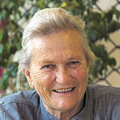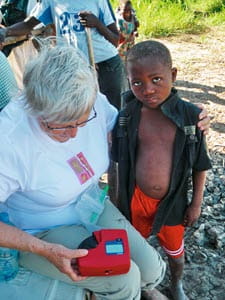With passion to help
When Doctor Ingegerd Rooth and Nurse Marita Johansson talk about “their children”, they are referring to the hundreds of children in the village of Nyamisati in Tanzania. Children whom they have examined and treated over the years. The two Swedes have lived and worked there for almost twenty years, fighting against the deadly disease malaria and for the health of the villagers. But these women have never felt that they’ve sacrificed anything. Quite the contrary.
“We feel that we are truly needed in this village in a way that’s completely different to back home. We’ve made friends for life here,” says Marita Johansson.
In the mid 1980s, Marita Johansson was working as a matron and Ingegerd Rooth as a doctor in charge of a missionary hospital in Tanzania. Every now and then, children dying of malaria were brought to the hospital. Sometimes they arrived in time, sometimes it was too late. Ingegerd Rooth recalls,
“On Saturdays, we travelled out into the delta to find out first hand the state of health of the children in the village. They were severely anemic due to malaria and a poor diet. They weren’t even able to play, they just sat doing nothing. We really wanted to do something for them, but we were aware that, as white foreigners, we might not be welcomed with open arms by the villagers”.
 Ingegerd Rooth came to Kongo in 1956 as a nurse and mid-wife. After four years, she went home to Sweden to study medicine. Six years later, she went back to Kongo, now as a medical doctor. In 1979, she moved to the Mchukwi hospital in Tanzania.
Ingegerd Rooth came to Kongo in 1956 as a nurse and mid-wife. After four years, she went home to Sweden to study medicine. Six years later, she went back to Kongo, now as a medical doctor. In 1979, she moved to the Mchukwi hospital in Tanzania.
 Marita Johansson came to Tanzania in 1969 where she worked as a nurse anesthetist at the Mchukwi hospital. Marita Johansson and Ingegerd Rooth have worked together since 1979 and moved to Nyamisati in 1986.
Marita Johansson came to Tanzania in 1969 where she worked as a nurse anesthetist at the Mchukwi hospital. Marita Johansson and Ingegerd Rooth have worked together since 1979 and moved to Nyamisati in 1986.
 NYAMISATI HEALTH CENTER Nyamisati Health Center started as a thatched shelter. That was when Ingegerd Rooth and Marita Johansson first came to the village in 1986. Soon they initiated the construction of a house built of clay to accommodate a maternity ward and the dispensary. Thanks to a private donation a little less than twenty years ago, the dispensary is now a proper concrete house. The patients of Nyamisati Health Center come from the village itself and from the surrounding islands. The typical patient is a child with malaria, diarrhoea, or pneumonia, or a woman giving birth. Four people work in the clinic in addition to the staff running the malaria research project organized from Karolinska Institutet in Sweden.
NYAMISATI HEALTH CENTER Nyamisati Health Center started as a thatched shelter. That was when Ingegerd Rooth and Marita Johansson first came to the village in 1986. Soon they initiated the construction of a house built of clay to accommodate a maternity ward and the dispensary. Thanks to a private donation a little less than twenty years ago, the dispensary is now a proper concrete house. The patients of Nyamisati Health Center come from the village itself and from the surrounding islands. The typical patient is a child with malaria, diarrhoea, or pneumonia, or a woman giving birth. Four people work in the clinic in addition to the staff running the malaria research project organized from Karolinska Institutet in Sweden.
They asked for our help
But one day they received a letter from the fifty men who lived in the village, requesting Ingegerd Rooth and Marita Johansson to visit the village and talk to them.
“Quite simply, they wondered if we would consider moving to their village to live there. The women and children liked us and the men realized that we could help them,” Ingegerd Rooth explains.
There was absolutely nothing there when Ingegerd Rooth and Marita Johansson arrived in 1986. No water, no sewage system, nowhere to meet patients and no health care equipment. They made it a priority to have a clinic, a maternity ward and a school built.
Hb colour scale method not reliable
Since malaria and the resulting anemia are a huge problem in Tanzania, and since this was also the subject of Ingegerd Rooth’s dissertation, it was important to be able to take accurate hemoglobin (Hb) measurements. Marita Johansson explains,
“Initially, we used the Tallqvist paper method of testing which uses a color scale to determine the approximate Hb. But the results that Ingegerd was getting weren’t the same as mine. This meant that we couldn’t use the results for the studies in the dissertation. I remembered reading in the Swedish medical journal ”Läkartidningen” that HemoCue’s Hb instrument was supposed to be very accurate. So I phoned them and asked if they would be interested in helping us, and they were.”
Quick disease progress requires accurate Hb method
Over a three-year period, Ingegerd Rooth and Marita Johansson recorded all cases of fever in the village, compared the occurrence of malaria during the dry and the rainy seasons, measured Hb levels and counted malaria parasites in blood. The findings, which Ingegerd Rooth presented in her PhD-thesis in 1992, became the foundation for the World Health Organization’s criteria for diagnosing malaria.
Ingegerd Rooth and Marita Johansson lived in Nyamisati until 2003 when, entitled by their age, they moved home again. During the time they lived in the village, its population rose from 400 to 2000. Malaria is a huge health problem in Tanzania. 80 percent of children are infected with malaria before the age of one, and all children are infected by the age of five. Infants are most seriously affected by malaria. Ingegerd Rooth explains,
“Malaria progresses very quickly in infants. The attacks, when the red blood cells are destroyed, occur every 48 hours. During an attack, the hemoglobin level can drop from nine to six g/dL then down to four g/dL at the next attack and then the child dies. If the child is admitted to hospital in time, treatment can begin immediately and hopefully further attacks are prevented. That’s why it’s critically important to be able to measure Hb levels at the point of care and know that the results are accurate.”
Hb and WBC in combination for improved diagnosis
In 2010, they returned to Nyamisati for two months to carry out a review of the state of health in the village and the surrounding region. Not only had they packed HemoCue’s Hb instrument for their visit. This time they also took HemoCue’s WBC (White Blood Cell) count instrument with them, as they wanted to investigate whether it is possible to differentiate between fever caused by malaria and fever caused by other infections.
The conditions for field studies in areas like Nyamisati are not always optimal for lab work. Instruments for use point of care need to be robust enough to withstand both extreme heat and humidity, but of course without giving up the demand for lab quality results. Ingegerd Rooth and Marita Johansson were very pleased with the HemoCue instruments they used for their field studies.
“The equipment was easy to bring, and although it is indeed very humid in Nyamisati, the cuvettes are well packed so this is not a problem,” says Marita Johansson.
All in all, they examined 930 people during their visit. Working on site they determined hemoglobin and white blood cell counts, counted parasites in blood through microscopes and performed quick HIV tests. They also handed out mosquito nets to everyone they examined.
Ingegerd Rooth and Marita Johansson have now returned home again. Their colleagues in Nyamisati make sure that the work of the clinic continues.

